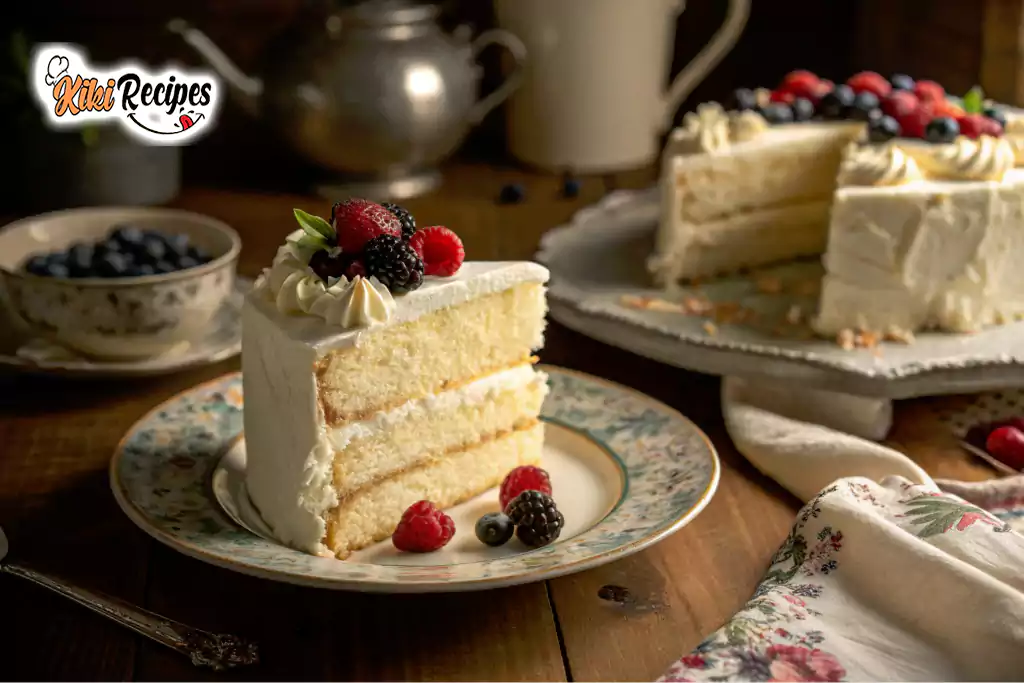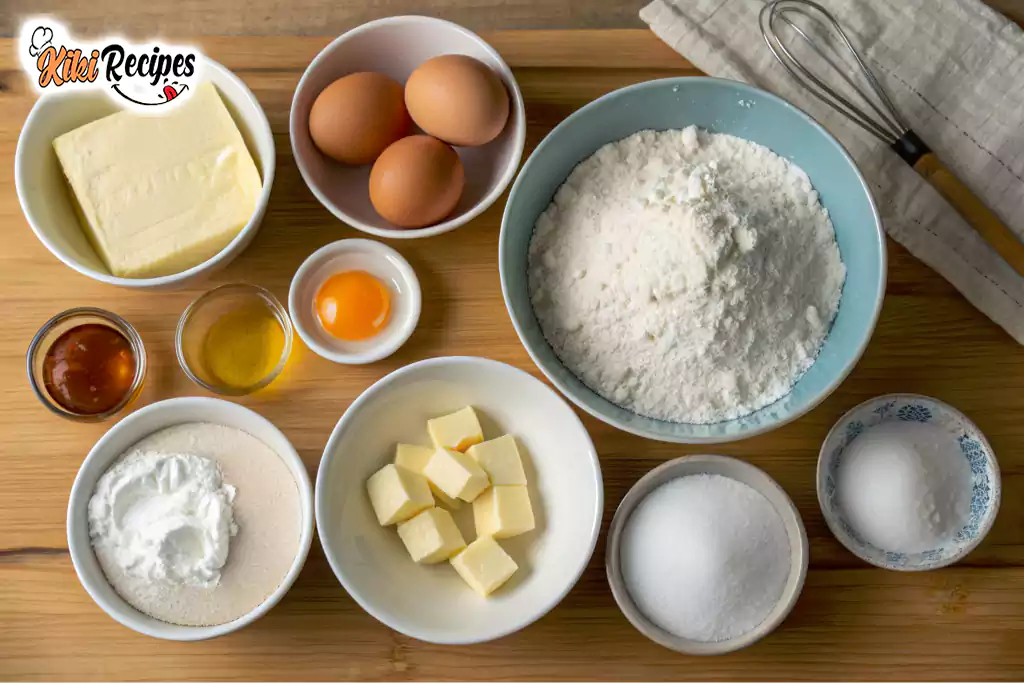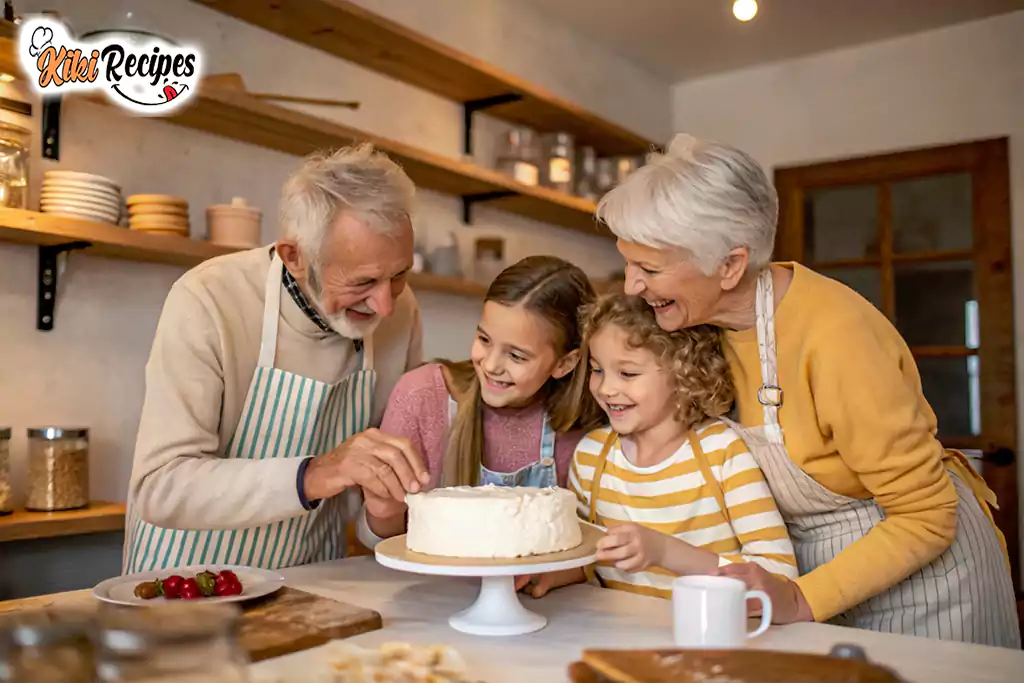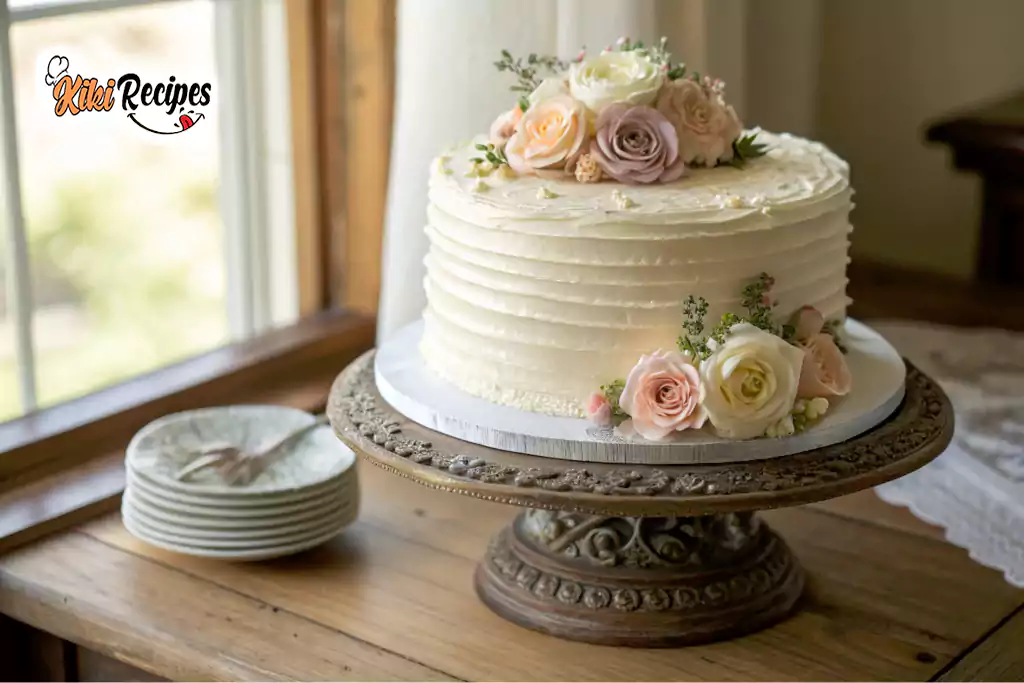
Introduction to Grandma’s White Cake Recipe
When it comes to comfort food, few things can rival the timeless appeal of a homemade cake. And if you’re craving a slice of something classic, Grandma’s white cake recipe is bound to be your new go-to. This cake isn’t just about the ingredients or the process—it’s about tradition, nostalgia, and a dash of love baked into every bite.
The beauty of Grandma’s white cake lies in its simplicity. With a handful of staple ingredients—flour, sugar, eggs, butter—you can create a light, fluffy cake that tastes just like it’s been passed down through generations. Whether you’re celebrating a birthday, hosting a family gathering, or just craving a sweet treat, this cake will never let you down.
So, why is this cake so special? Well, it’s not just any white cake. It’s the perfect white cake. Moist, delicate, and subtly sweet, it has all the qualities that make it a favorite for family events and special occasions. In this article, we’ll break down everything you need to know, from selecting the right ingredients to perfecting your frosting technique.
Let’s get started on creating a cake that will impress everyone who takes a bite, all while staying true to that old-fashioned charm that makes Grandma’s white cake a true classic.
What is Grandma’s White Cake?
Grandma’s white cake is the epitome of what many consider a “classic” cake. It’s made with simple ingredients, and the method is straightforward, yet the end result is nothing short of spectacular. The beauty of this cake lies in its light texture and the soft, subtle vanilla flavor that makes it versatile enough to pair with any frosting or filling of your choice.
What makes it stand out is the nostalgia. For many, Grandma’s white cake recipe is a cherished family heirloom passed down through generations. It’s the cake that was served at birthdays, weddings, and holiday dinners. And even if it’s not the first cake you bake, it’s likely to be the one that makes you feel like you’re in a cozy kitchen, surrounded by loved ones.
When you think of a cake that’s just right, it’s this one. It’s a perfect balance of sweetness, fluffiness, and tenderness. Whether you’re an experienced baker or a novice, you’ll appreciate how easy this recipe is to make while still delivering a decadent, show-stopping result.
Why Choose Grandma’s White Cake Recipe?
You might be wondering, “Why should I choose Grandma’s white cake recipe over the hundreds of other white cake recipes out there?” The answer is simple: this cake is not only delicious, but it also carries a piece of history with it.
The recipe is incredibly forgiving—even beginner bakers can master it. Plus, it uses basic pantry ingredients that most people already have on hand. There’s no need for complicated tools or hard-to-find supplies. It’s perfect for those last-minute baking moments when you want something special but don’t have hours to spare.
Moreover, this cake can be dressed up or down to fit any occasion. You can serve it plain with a dusting of powdered sugar for a simple, elegant dessert, or you can go all out with a rich, fluffy frosting to make it the star of your birthday party or holiday feast.
In addition, making this cake isn’t just about baking. It’s about connecting with family traditions. When you bake Grandma’s white cake, you’re not just making a dessert—you’re creating a moment. A moment that’s filled with love, laughter, and memories that last.
Ready to dive in and start baking? Let’s take a closer look at the key ingredients you’ll need for Grandma’s white cake recipe. Trust me, you’ll want to get this part just right!
Ingredients for Grandma’s White Cake Recipe

To make the perfect Grandma’s white cake, you don’t need anything fancy—just a handful of pantry staples. It’s one of those recipes where simplicity truly shines. Each ingredient plays a crucial role in making the cake light, tender, and delicious, so it’s important to choose quality ingredients and follow the steps carefully. Let’s break down the essentials:
Essential Ingredients for Grandma’s White Cake
Here’s what you’ll need:
- All-purpose flour
The foundation of any cake. All-purpose flour works perfectly for this white cake, giving it that light, fluffy texture. Avoid using cake flour unless the recipe specifies, as it can alter the consistency. - Granulated sugar
For sweetness and structure. Sugar not only sweetens the cake but also contributes to its texture by helping with the creaming process when mixed with butter. - Butter (unsalted)
Butter is key for flavor. Unsalted butter is best because it lets you control the salt content of the cake. The butter should be at room temperature, soft enough to cream but not melted. - Eggs
Eggs bind the ingredients together and help with the structure and rise of the cake. Use large, fresh eggs for the best results. - Baking powder
The leavening agent that makes the cake rise. Be sure your baking powder is fresh, as expired baking powder will not give your cake the lift it needs. - Milk
Whole milk is ideal for keeping the cake moist and adding richness. You can use buttermilk for an extra tangy flavor, but it’s not required in Grandma’s traditional recipe. - Vanilla extract
Vanilla is what gives this cake its classic, comforting flavor. Opt for pure vanilla extract over imitation for the best taste. - Salt
A pinch of salt is essential to balance the sweetness of the cake and bring out all the flavors.
Ingredient Tips for Perfect Results
Now that we’ve got the basics down, let’s talk about how to get the best out of these ingredients:
- Use high-quality butter: Butter is the backbone of flavor in this cake, so choose the best you can find. A rich, creamy butter will make a world of difference in the final result.
- Fresh eggs: Fresh eggs will help your cake rise properly and provide a richer flavor. If you’re in a pinch, be sure your eggs are at room temperature to prevent any curdling when mixing.
- Vanilla extract: Pure vanilla extract is the secret ingredient that makes this cake stand out. Don’t skimp on this—the flavor is subtle but plays a key role in the overall taste of the cake.
- Room temperature ingredients: For the smoothest batter and the fluffiest cake, make sure your butter, eggs, and milk are all at room temperature. This ensures the ingredients combine evenly, resulting in a tender cake.
Can I Substitute Ingredients?
Sure! While the traditional Grandma’s white cake recipe relies on these basic ingredients, there are a few substitutions you can make if you need to accommodate dietary preferences or restrictions.
- Vegan alternatives: To make this cake vegan, substitute the butter with vegan butter and the eggs with a flaxseed or chia egg substitute (1 tablespoon of ground flax or chia mixed with 2.5 tablespoons of water for each egg). Use almond or soy milk in place of regular milk, and choose a plant-based vanilla extract.
- Gluten-free options: If you’re gluten-sensitive, you can swap the all-purpose flour for a gluten-free flour blend. Make sure the flour blend contains xanthan gum or another binder to help the cake rise.
- Sugar substitutes: Want to reduce the sugar content? You can use coconut sugar or stevia as a sugar substitute, but keep in mind that this might slightly alter the texture and flavor of the cake. Always follow specific instructions for sugar substitutes to get the best results.
Remember, these substitutions might slightly change the texture and flavor of the cake, but they’ll still yield a delicious result.
What About Frosting?
Now that you’ve got all your ingredients in place, you might be wondering: What about frosting? Grandma’s white cake is often paired with a simple buttercream frosting, but you can go as fancy or as minimal as you like. We’ll dive into frosting options in the next section, but just know that the beauty of this cake lies in its versatility. Whether you choose a classic buttercream or a fruity whipped topping, it’ll be the perfect match.
Step-by-Step Instructions for Making Grandma’s White Cake
Now that you have your ingredients ready, it’s time to roll up your sleeves and start baking! Grandma’s white cake is all about following a few simple steps and bringing everything together to create a light, fluffy, and utterly delicious cake. The method is straightforward, but a little attention to detail will ensure your cake turns out perfectly every time. Let’s break it down, step by step:
Preparing the Oven and Cake Pans
The first step in making Grandma’s white cake is getting your oven preheated. Set it to 350°F (175°C), which is the ideal temperature for this cake. While the oven is warming up, you’ll also need to prep your cake pans.
- Grease the pans: Use butter or cooking spray to grease two 9-inch round cake pans. Then, line the bottoms of the pans with parchment paper. This ensures that your cake doesn’t stick and makes it easier to remove after baking.
- Flour the pans: After greasing, lightly dust the pans with flour, shaking out any excess. This step ensures that the cake slides right out after it’s done baking.
This preparation is crucial for a smooth, stress-free cake release, so don’t skip it!
Mixing the Dry Ingredients
Now, it’s time to get your dry ingredients together. Sifting them will help prevent any clumps and ensure they’re evenly mixed throughout the batter.
- Sift together the flour, baking powder, and salt: Start by sifting 2 ½ cups of all-purpose flour into a bowl. Then, add 1 ½ teaspoons of baking powder and ½ teaspoon of salt. This combination will give your cake the perfect rise and a balanced flavor.
The sifting process is important to prevent any flour lumps and to help the leavening agents (baking powder) distribute evenly throughout the flour.

FAQ Section: Common Questions About Grandma’s White Cake Recipe
1. What’s the Difference Between Vanilla Cake and White Cake?
At first glance, vanilla cake and white cake might seem similar, but there’s a subtle difference. While both cakes have the same base ingredients, the main difference lies in the egg yolks.
- Vanilla cake typically uses whole eggs, which give it a richer flavor and slightly yellow color due to the yolk.
- White cake, on the other hand, only uses egg whites to ensure the cake is as light and white as possible. The lack of egg yolks results in a softer texture and a brighter, whiter color.
Essentially, Grandma’s white cake is a variation that focuses on purity in color and lightness, making it ideal for occasions where you want a more delicate, pale cake.
2. What is the Secret to Super Moist Cake?
If you’re looking for that ultra-moist texture in your Grandma’s white cake, the key lies in the combination of ingredients and technique. Here are a few tips to ensure your cake stays moist:
- Use room temperature ingredients: Cold butter or eggs can make your batter dense and not as airy. Let your butter, eggs, and milk sit at room temperature before mixing them.
- Don’t overmix the batter: Overmixing can lead to a dense cake. Mix the ingredients until just combined to maintain that airy, light texture.
- Add a moistening agent: Ingredients like sour cream, buttermilk, or even a little bit of vegetable oil can add extra moisture to your cake without affecting the flavor.
- Properly cool the cake: Let the cake layers cool in the pan for about 10 minutes before removing them. This will help them retain moisture and keep them tender.
By following these steps, your white cake will be moist and delicious every time!
3. Why Do You Only Use Egg Whites in White Cake?
One of the defining features of white cake is the use of only egg whites, and this is done for both aesthetic and texture reasons:
- Aesthetic reasons: The absence of egg yolks helps maintain the bright, white color of the cake. Egg yolks contain fat and pigments that can make the cake look slightly yellow, so using only the whites ensures a pure, snowy-white finish.
- Texture reasons: Egg whites contribute to the cake’s delicate, airy structure. Without the richness of the egg yolks, the cake becomes lighter and fluffier—just like the one you’d expect from a classic white cake.
Using egg whites is all about creating a lighter, airier texture while achieving that pristine, white color.
4. What Does White Vinegar Do in Cake?
White vinegar might sound unusual in a cake recipe, but it actually plays a key role in helping your white cake rise and become super fluffy:
- Activates the baking soda or powder: Vinegar reacts with the baking powder to create bubbles of carbon dioxide, which helps the cake rise and become light. This chemical reaction is what makes your cake rise evenly without becoming dense.
- Helps balance flavors: A tiny bit of vinegar also helps to neutralize any overly sweet flavors and enhances the overall taste of the cake.
While it may seem like a small addition, white vinegar is an essential ingredient that contributes to the perfect texture and flavor of your cake.
Conclusion
In conclusion, Grandma’s white cake recipe is a timeless classic that’s easy to make and full of charm. From the simple yet essential ingredients to the step-by-step process, every part of this cake is designed to create something truly special. Whether you’re baking for a family gathering, a birthday, or just because, this cake will never disappoint.
The beauty of Grandma’s white cake lies in its versatility and simplicity. It’s a blank canvas that can be paired with any frosting, making it ideal for all kinds of occasions. By following the tips in this article—whether it’s using the right ingredients, perfecting your technique, or selecting the right frosting options—you’ll end up with a cake that’s light, fluffy, and guaranteed to leave everyone asking for more.
So, go ahead, try this classic white cake recipe and enjoy the taste of nostalgia with every bite.

